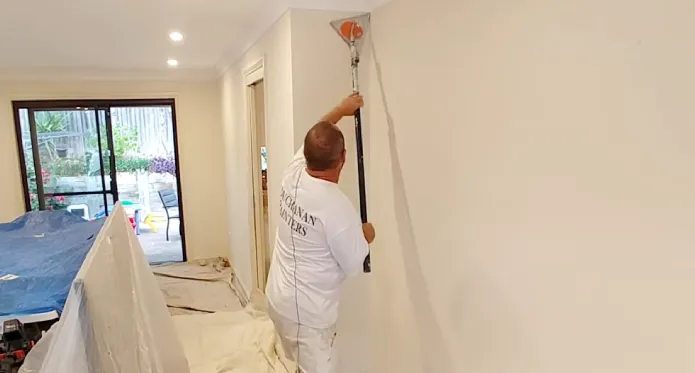Last Updated on July 30, 2023
To achieve a flawless finish when painting drywall, the choice of sandpaper is one of the most important steps. With a wide range of grit sizes available, selecting the right one can be difficult.
Coarse-grit sandpaper can quickly remove old paint and prepare surfaces for priming, while medium-grit sandpaper can add minor smoothing, and fine-grit paper can help create a super smooth surface for painting.
We will discuss what grit sandpaper to use on drywall for primer before painting, factors to consider when choosing the right grit size, and safety measurements to take when using sandpaper.
What Grit Sandpaper for Primer Before Painting Drywall: Ingredients

Grit is the abrasive particles on a piece of sandpaper and is typically made from materials such as aluminum oxide, silicon carbide, or garnet. The type of grit used in sandpaper can affect its performance and suitability for different tasks. Here are a few common types of grit used in sandpaper:
Aluminum oxide
This is a synthetic grit that is made from aluminum oxide crystals. It is a popular choice for sandpaper due to its durability, versatility, and affordability. Aluminum oxide grit is suitable for sanding a wide range of materials, including wood, metal, and plastic.
Silicon carbide
The grit is synthetic and consists of silicon carbide crystals. It is a harder and sharper grit than aluminum oxide and is often used for sanding very hard materials, such as stone or ceramic. Silicon carbide grit is also suitable for sanding metal and wood and is available in various grit sizes.
Garnet
This is a natural grit that is made from crushed garnet crystals. It is a softer and more brittle grit than aluminum oxide or silicon carbide and is generally used for sanding wood and other softer materials. Garnet grit is available in a range of grit sizes but is generally not as durable as synthetic grits.
Coarse Grit Sandpaper
Coarse grit sandpaper is a type of sandpaper that is typically used for heavy sanding or removing deep imperfections in surfaces. It is often used on rough or uneven surfaces, such as drywall, to design the surface for priming and painting.
Applications of Coarse Grit Sandpaper

Use 01: Sanding Rough Surfaces to Remove Deep Imperfections
Coarse grit sandpaper is effective at removing deep scratches, dents, or other imperfections from surfaces if the drywall surface is particularly rough. It can be used to smooth out rough or uneven drywall, making it ready for priming and painting.
Grit Sizes for Coarse Grit Sandpaper
Coarse grit sandpaper is commonly obtainable in grit sizes ranging from 80 to 100. The lower the grit number, the coarser the sandpaper. For example, 80-grit sandpaper is coarser than 100-grit sandpaper.
Medium Grit Sandpaper
Medium-grit sandpaper is used for general sanding and smoothing out imperfections in surfaces. It is a versatile grit size that is often used on drywall to condition the surface for priming and painting.
Applications of Medium Grit Sandpaper
Use 01: Smoothing Out Imperfections
Medium-grit sandpaper is effective at smoothing out minor scratches, dents, or other imperfections on surfaces. It can be used to prepare drywall for priming and painting by removing any minor imperfections and creating a smooth, even surface.
Use 02: General Sanding
Medium-grit sandpaper is a good all-purpose grit size for sanding drywall. It can be used for both rough and smooth surfaces, making it a suitable choice for most sanding projects.
Grit Sizes for Medium-grit Sandpaper
Medium-grit sandpaper is typically available in grit sizes varying from 100 to 180. Medium-grit sandpapers are coarser when their grit number is lower. For example, 100-grit sandpaper is more boorish than 180-grit sandpaper.
Fine Grit Sandpaper
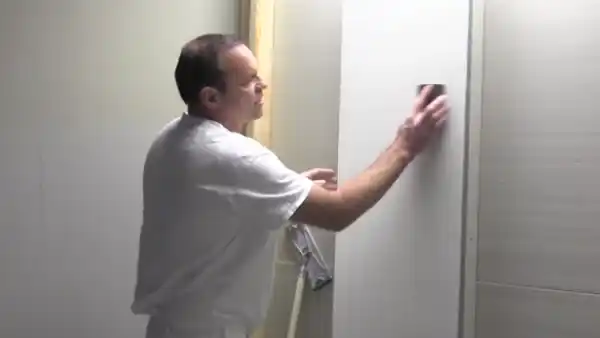
Fine-grit sandpaper is used for final sanding and smoothing out surfaces. It is typically used on drywall to prepare the exterior for priming and painting and can create a very smooth, even finish.
Applications of Fine Grit Sandpaper
Use 01: Final Sanding
Fine-grit sandpaper is used for the final sanding step before priming and painting. It can be utilized to smooth out the surface and prepare it for a flawless paint job.
Use 02: Smoothing Out Surfaces
Fine-grit sandpaper is effective at creating a very smooth, even surface on drywall. It is often used to remove any remaining imperfections or roughness before priming and painting.
Grit Sizes for Fine-grit Sandpaper
Sandpaper with fine grit sizes ranges from 220 and higher. The higher the grit size, the finer the abrasive particles on the sandpaper and the smoother the resulting finish. For example, 220-grit sandpaper is coarser than 400-grit sandpaper and will create a rougher finish.
Some common size grits for fine-grit sandpaper include:
220 Grit: This 220 grit size is suitable for heavy-duty sanding and shaping tasks, as well as for removing imperfections in the drywalls. It is less fine than larger grit sizes and will construct a rougher finish.
240 Grit: This 240 grit size is often used to sand after coats of paint or finish.
280 Grit: This 280 grit size is repeatedly used to prepare surfaces for clear finishes.
320 Grit: This 320 grit size creates a high-gloss finish on wood and other materials.
Factors to Notice When Choosing Grit Size
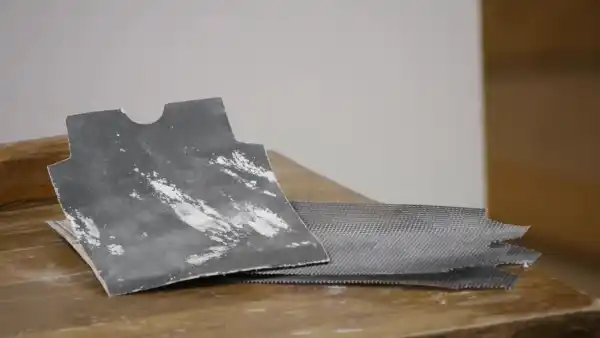
Factor 01. Type of primer and paint
Different types of primer and paint may require different grit sizes for sanding. For example, some primers and paints may be more forgiving and able to hide imperfections, while others may be more sensitive and require a smoother surface.
Consider the type of primer and paint you will use.
Factor 02. Condition of drywall surface
The condition of the drywall surface is also an important factor to consider when preferring a grit size. If the surface is rough or has deep imperfections, coarse grit sandpaper may be necessary to remove these imperfections.
If the surface is already fairly smooth, a finer grit sandpaper may be sufficient to prepare the surface for priming before painting.
Factor 03. Personal preference
Personal preference is also a factor to think about when choosing a grit size. Some people may prefer a smoother, finer finish, while others may be more forgiving of imperfections and prefer a coarser grit. Consider your preferences when selecting a grit size for sanding drywall.
Importance of the Right Grit Size
When prepping a wall for painting, selecting the proper grit size of sandpaper is essential for several reasons. The optimal choice can influence everything from surface smoothness to labor intensity and overall job quality. Consider taking extra care when deciding on which product will best suit your drywall project’s needs.
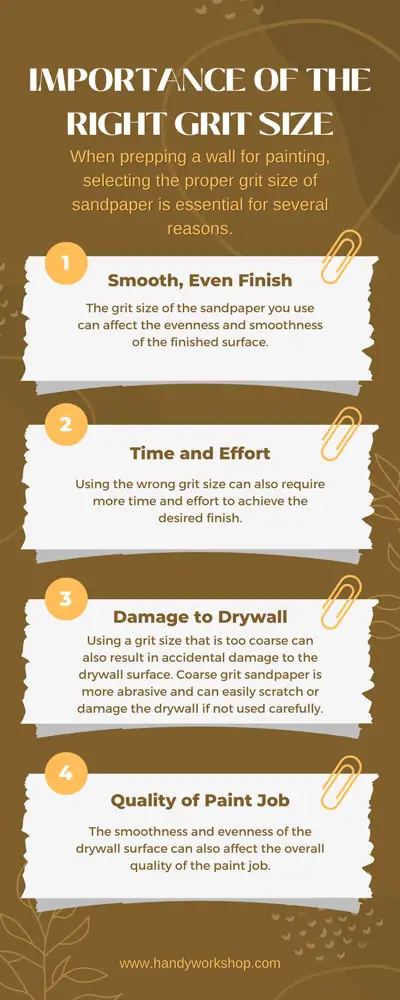
Reason 1: Smooth, Even Finish
The grit size of the sandpaper you use can affect the evenness and smoothness of the finished surface.
A grit size that is excessively rough can leave scratches or unevenness on the surface, and the scratches will be visible after priming and painting.
A grit size that is overly fine may not be effective in removing imperfections or roughness, and the roughness or flaws will result in an irregular or poorly finished surface.
Reason 2: Time and Effort

Using the wrong grit size can also require more time and effort to achieve the desired finish. If you use a grit size too coarse, you may need to sand the drywall multiple times to remove all of the imperfections, which can be time-consuming.
On the other hand, using a grit size too fine may not effectively remove imperfections, requiring additional sanding or other preparation methods.
Reason 3: Damage to Drywall
Using a grit size that is too coarse can also result in accidental damage to the drywall surface. Coarse grit sandpaper is more abrasive and can easily scratch or damage the drywall if not used carefully.
Reason 4: Quality of Paint Job
The smoothness and evenness of the drywall surface can also affect the overall quality of the paint job. If the drywall is uneven or imperfect, it can result in an uneven or shoddy paint job. Using the right grit size for sanding helps ensure a smooth, even surface, which can lead to a better-quality paint job.
Safety Measurements
Using sandpaper on drywall can create a lot of dust, which can be harmful if inhaled. Therefore, it is important to take certain safety precautions when sanding drywall:
Safety Measure 01
Wear a dust mask to protect your respiratory system from drywall dust.
Safety Measure 02
Use eye protection, such as goggles, to protect your eyes from the drywall dust that may be kicked up while sanding.
Safety Measure 03
Wear earplugs or earmuffs to protect your hearing from the noise of the sanding process.
Safety Measure 04
Use a sanding sponge or sanding block to ensure even sanding and to prevent deep scratches or damage to the drywall surface.
Safety Measure 05
Wipe down the sanded surface with a damp cloth to remove any dust. This will also help to reduce the amount of dust in the air.
Safety Measure 06
If you are using an electric sander, follow all safety instructions and precautions the manufacturer provides.
Safety Measure 07
If you are working in a poorly ventilated area, open windows or use a fan to help circulate fresh air.
By following these safety measures, you can protect yourself and others from the potential hazards of sanding drywall.
Should You Choose Coarse Grit Sandpaper or Medium Grit Sandpaper?
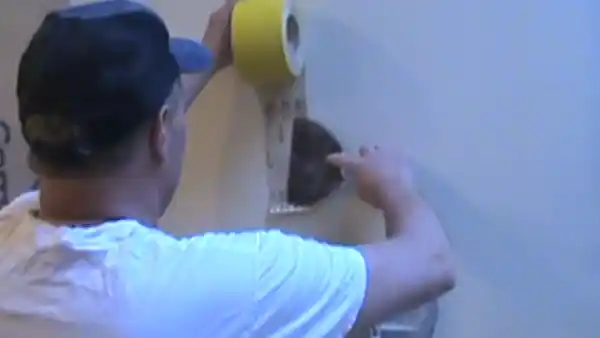
The choice between coarse-grit sandpaper and medium-grit sandpaper will depend on the specific task you are trying to accomplish. Here are a few things to think about when deciding which grit size to use:
01. The Type of Material You are Sanding
Coarse grit sandpaper is best suited for heavy-duty sanding projects and is typically used on rough surfaces. It is effective at shaping and smoothing wood and other materials and can be used to remove old paint or finishes.
On the other hand, medium grit sandpaper is better suited for smoothing and finishing tasks and is often used to prepare surfaces for painting or staining. It is less abrasive than coarse grit sandpaper and is better suited for removing minor imperfections in the wood and other materials.
02. The Desired Level of Smoothness
Coarse grit sandpaper will create a rougher, more uneven surface, while medium grit sandpaper will create a smoother, more even surface. If you are trying to achieve a very smooth finish, you may want to use medium grit sandpaper or even finer grit sizes.
03. The Type of Sanding Tool You Use
Different sanding tools are better suited for different grit sizes. For example, orbital sanders are generally better suited for medium-grit sandpaper, while belt sanders are better suited for coarse-grit sandpaper.
Start with coarse-grit sandpaper for heavy-duty sanding tasks and then progress to medium or fine-grit sandpaper for smoothing and finishing. This will help to ensure that you achieve the desired level of smoothness and finish your project.
When Should You Choose Fine Grit Sandpaper?
Fine grit sandpaper, with grit sizes of 220 and higher, is typically used for final smoothing and finishing tasks. It is characterized by its very smooth, fine abrasive particles. Here are a few situations in which you might choose to use fine grit sandpaper:
For Final Smoothing and Finishing

Fine-grit sandpaper is highly effective at smoothing out any remaining imperfections in the wood, which can improve the overall appearance of the finished project.
It is often used for last smoothing and polishing, such as sanding between coats of paint or preparing a surface for a clear finish.
For Creating a Smooth, Even Surface
Fine-grit sandpaper is ideal for creating a smooth surface on wood and other materials. This can be desirable when a very smooth finish is desired, such as creating a high-gloss finish.
During the Painting Process
Fine-grit sandpaper is often used to sand between coats of paint or finish to give the paint a smooth, even surface. This helps to ensure a professional-looking finish on the project.
Prepare Surfaces for Opaque Finishes
Fine-grit sandpapers are also often used to prepare the wood and other surfaces for clear finishes, such as lacquer or varnish. It is effective at removing any remaining imperfections on the surface and creating a smooth, even base for a clear finish.
Final Thoughts
Choosing the appropriate grit size for sandpaper when working with drywall is critical for achieving a good primer base before painting. While it may seem complicated at first due to the different options available, understanding why certain grit sizes work better than others can help make choosing much easier.
It’s important to remember to always wear protective gear when working with power tools or chemically-treated surfaces, such as sandpaper. Investing in quality tools will also make sure your job comes out looking great every time.
With these tips in mind, you should have no problem finding just what type of grit sandpaper works best for prepping drywall before priming and painting your next project.
